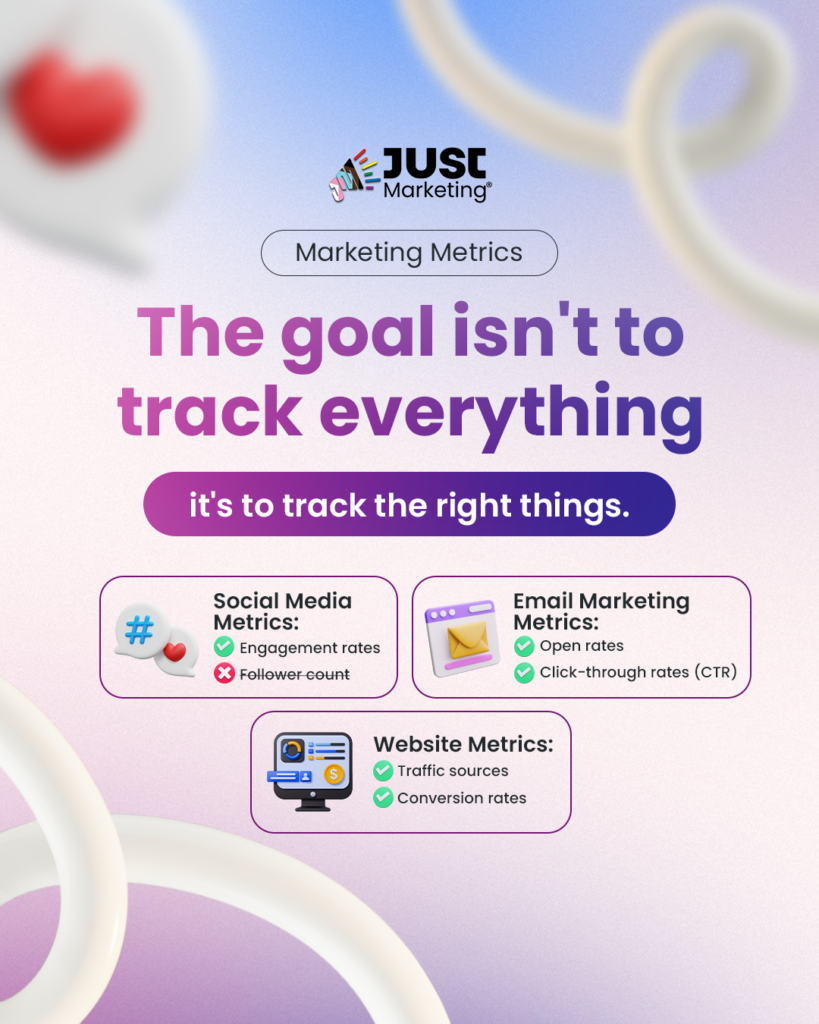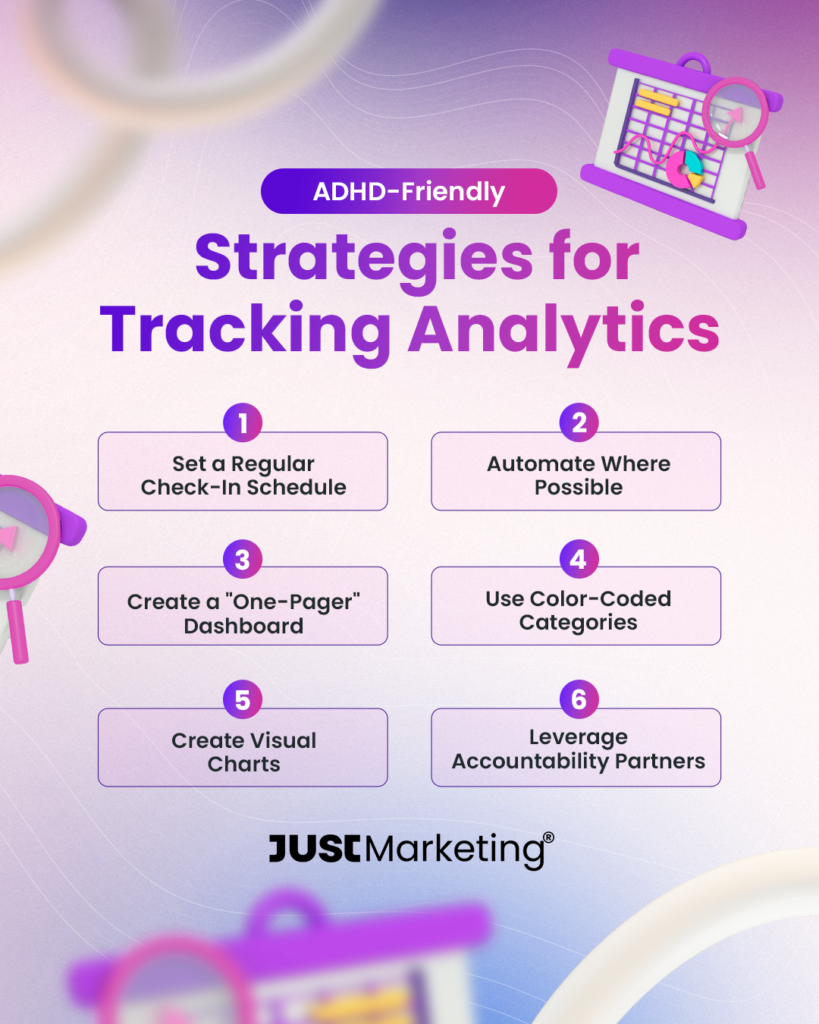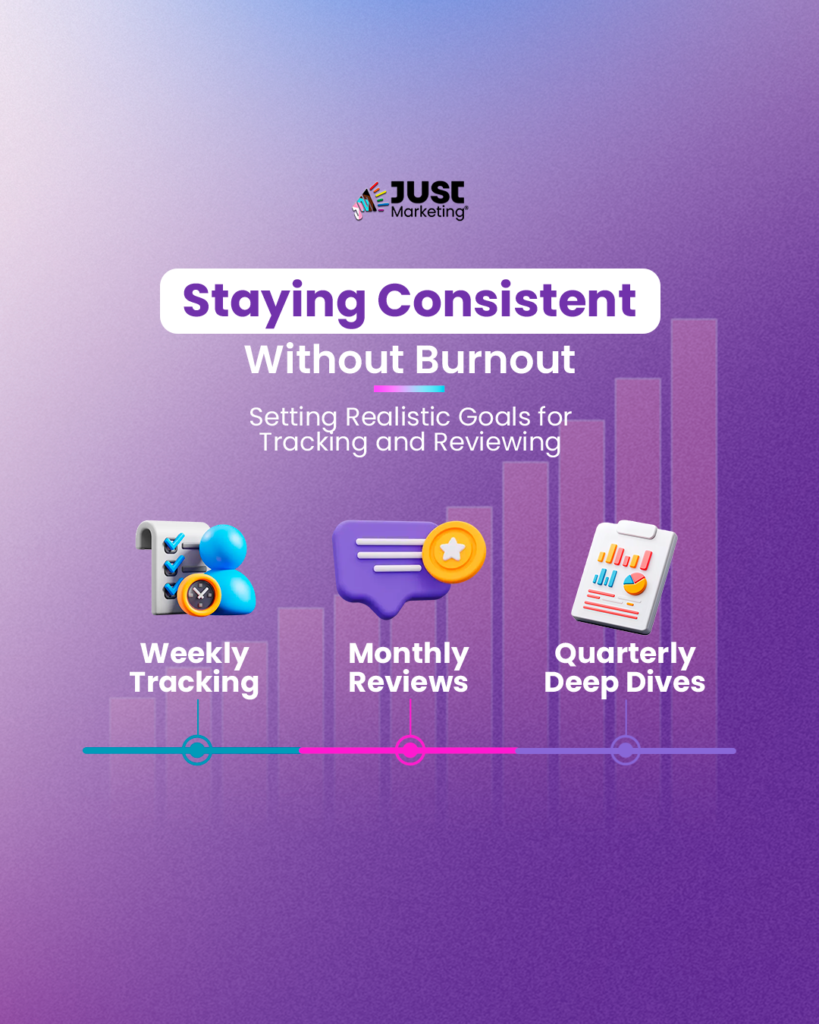Does the thought of tracking your marketing efforts send you into a spreadsheet spiral? For many mission-driven entrepreneurs, the idea of analyzing metrics feels overwhelming – especially when you’re juggling everything else on your plate. But here’s the thing: tracking your marketing data doesn’t have to be stressful or time-consuming…and, it can be a game-changer for your business.
When you know what’s working (and what’s not), you can make smarter decisions, save time, and ensure your marketing strategies align with your values and are profitable. It’s not about chasing vanity metrics or perfection – it’s about finding clarity and using that insight to grow your business authentically.
In this post, I’ll show you how to track your marketing data in a way that’s simple, ADHD-friendly, and designed to keep overwhelm at bay. You’ll also learn how to adjust your strategies with confidence, so you’re always moving toward your goals without getting stuck in the weeds.
Identifying Key Metrics That Matter (and Ditching the Rest)
When it comes to tracking your marketing success, less is more. Instead of drowning in a sea of stats, focus on a few key metrics that align with your goals. The right data can give you clarity and direction without adding to your overwhelm.

Focus on the Marketing Data that Matters Most
Here are some examples of high-impact metrics to track, based on common marketing goals:
- Social Media: Engagement rates (likes, comments, shares, saves) over follower count. Why? Because engagement shows genuine interest and connection, while follower count is often just a vanity metric.
- Email Marketing: Open rates and click-through rates (CTR). These metrics reveal how effectively your emails are reaching and resonating with your audience.
- Website: Traffic sources (where your visitors are coming from) and conversion rates (how many people are taking action, like signing up for your email list). This data can help you fine-tune your content and marketing channels.
Simplify Your Marketing Data Dashboard
The goal isn’t to track everything – it’s to track the right things. Ask yourself:
- What’s the purpose of this channel or campaign?
- What actions do I want my audience to take?
- Which data points show me if I’m on track?
For example, if your goal is to grow your email list, tracking social media shares or impressions isn’t as helpful as monitoring how many people actually clicked through to your sign-up page.
Quality Over Quantity
Here’s the big takeaway: It’s better to have 100 engaged followers than 1,000 who scroll past your content. Meaningful engagement – whether it’s a thoughtful comment, a reply to your email, or a referral – is a more valuable indicator of success than sheer numbers.
By narrowing your focus to a few key metrics, you can get actionable insights without feeling buried under data.
Tools and Systems That Keep Marketing Data Manageable
Tracking your marketing success doesn’t have to involve complicated spreadsheets or hours of analysis. With the right tools and systems, you can gather the insights you need quickly and without overwhelm. Here are some simple, ADHD-friendly ways to keep your marketing data organized and actionable.
Beginner-Friendly Tools to Get You Started
You don’t need fancy software to start tracking effectively. Here are a few user-friendly options that do the heavy lifting for you:
- Google Analytics: A free tool to track website traffic, sources, and behavior. Use it to see which pages are getting the most attention and where your visitors are coming from.
- Social Media Analytics: Most platforms (like Instagram, Facebook, and LinkedIn) have built-in insights. Focus on engagement metrics like comments, saves, and shares.
- Email Marketing Platforms: Tools like Mailchimp, ConvertKit, or FGFunnels offer reports on open rates, click-through rates, and subscriber growth.

Overwhelm-Free Tips for Managing Marketing Data
Tracking doesn’t have to feel like a chore. These ADHD- and overwhelm-friendly strategies can help you stay on top of your numbers:
- Set a Regular Check-In Schedule: Block 30 minutes once a month to review your key metrics. Keep it consistent and short to avoid overthinking.
- Automate Where Possible: Many tools let you schedule reports to be sent directly to your inbox. Set it and forget it!
- Create a “One-Pager” Dashboard: Use a simple spreadsheet or document to record only the most important stats for each month. Seeing everything in one place keeps it manageable and helps you notice trends.
ADHD-Friendly Systems to Stay Consistent
Staying consistent is the key to making tracking work for you. Try these systems:
- Color-Coded Categories: Use colors to mark priority metrics so you can quickly identify the data that matters most.
- Visual Charts: Tools like Canva or Excel can help you create simple bar or pie charts to visualize trends at a glance.
- Accountability Partners: Share your tracking routine with a friend, team member, or coach to keep yourself on track without the added pressure of doing it alone.
By using tools and systems that fit your workflow, you’ll make tracking your marketing success not only easier but also more effective. Once you have the data, it’s time to analyze and adjust your strategies – and we’ll tackle that next.
Analyzing and Adjusting Strategies with a Growth Mindset
Now that you’ve got your marketing data organized, it’s time to use it. The magic of tracking isn’t just in collecting numbers – it’s in using them to make informed adjustments that align with your goals. Let’s break this process down so it feels doable and empowering, not overwhelming.

Analyze Marketing Data Without Overthinking
Tracking trends is more important than obsessing over every little spike or dip in your numbers. Ask yourself these questions to spot meaningful patterns:
- Did certain content (like a blog post or social media reel) perform better than others?
- Are you seeing steady growth in engagement, even if it’s slow?
- Are there consistent dips that might signal a need for change?
Look for big-picture insights instead of stressing over the details. For instance, if your Instagram saves are up, it could mean your audience loves the actionable tips you’ve been sharing recently – so create more of that content!
Questions to Guide Your Adjustments
When tweaking your strategy, keep it simple. Use these guiding questions:
- What’s working? Identify successful content, formats, or channels and consider doubling down on them.
- What’s not working? If something isn’t resonating, it’s okay to let it go or experiment with a different approach.
- What’s one small tweak I can test? For example, try posting at a new time, experimenting with a different headline style, or creating a new type of call-to-action (CTA).
Experimentation is Key
Marketing success rarely comes from doing the same thing over and over – it’s about testing and learning.
- A/B Testing: Compare two variations of a single element (like email subject lines) to see which performs better.
- Iterative Adjustments: Make small, incremental changes to your strategies instead of a complete overhaul.

Give It Time
Allow enough time to gather meaningful data before deciding if a change works. The timeline for testing depends on a few key factors:
- Your Audience Size:
- If your audience is small, you’ll need more time to collect enough data to see a clear pattern. For example, a small email list or niche social media following might require 2-3 months of consistent effort to show trends.
- If your audience is small, you’ll need more time to collect enough data to see a clear pattern. For example, a small email list or niche social media following might require 2-3 months of consistent effort to show trends.
- The Type of Strategy You’re Testing:
- Short-term experiments: Things like testing email subject lines, social media post formats, or posting times can often show results in 2-4 weeks.
- Longer-term strategies: Larger changes, like introducing a new content pillar or optimizing for SEO, may take 2-3 months or more to reflect in metrics like website traffic or conversions.
- Short-term experiments: Things like testing email subject lines, social media post formats, or posting times can often show results in 2-4 weeks.
- Your Goals:
- If your goal is brand awareness, it might take longer to see significant shifts in reach or impressions.
- For actions like sign-ups or purchases, trends may emerge more quickly.
Here’s a simple rule of thumb:
- For smaller changes (like tweaking CTAs or testing headlines), review results after a few weeks.
- For broader initiatives (like a new email series or blog strategy), give it at least 2-3 months to gather enough data.
Celebrate Progress, Not Perfection
Every experiment, whether it succeeds or fails, teaches you something valuable about your audience. Shift your mindset to view adjustments as opportunities for growth rather than judgments of your skills. Progress, even if it’s small, is worth celebrating.
By adopting a growth mindset and making data-informed adjustments, you’ll keep your marketing strategies fresh, effective, and aligned with your goals.
Staying Consistent Without Burnout
Consistency is key to building a successful marketing strategy, but it can also be one of the biggest challenges – especially if you’re juggling multiple responsibilities or navigating overwhelm. The good news? You don’t have to sacrifice your sanity to show up consistently. Here’s how to create sustainable habits that work for you.
Set Realistic Goals for Tracking and Reviewing Your Marketing Data

One of the biggest causes of burnout is trying to do too much, too fast. Instead of aiming to track every metric all the time, prioritize what’s manageable.
- Weekly Tracking: Checking in on metrics weekly ensures you stay on track, but commit to making major assessments or pivots only once a month or quarterly. This prevents premature changes based on short-term fluctuations.
- Monthly Reviews: For most small businesses, a monthly check-in on key metrics is enough to notice trends and make adjustments.
- Quarterly Deep Dives: Every 3 months, take a closer look at your overall progress and long-term goals.
By spacing out your tracking and review sessions, you can stay consistent without feeling like you’re constantly crunching numbers.
Automate and Delegate Where Possible
You don’t have to do it all yourself. Leverage tools and resources to make tracking easier:
- Automation Tools: Schedule reports from tools like Google Analytics, your email platform, or social media insights to be delivered directly to your inbox.
- Outsourcing: If tracking feels like a major time-suck, consider delegating it to a virtual assistant or marketing specialist who can provide you with a simple summary.
Create a Marketing Data Tracking Routine You Enjoy
Turn your tracking sessions into a habit that feels rewarding:
- Time-Block It: Set aside 30 minutes on the same day each month to review your marketing data.
- Add a Reward: Pair your review session with something you enjoy – like your favorite coffee or a celebratory playlist.
- Keep It Quick: Focus only on your top metrics to avoid falling into a rabbit hole of unnecessary data.
Celebrate Wins, Big and Small
Tracking often highlights areas for improvement, but don’t forget to celebrate what’s going well. Whether it’s a bump in engagement or hitting your first 100 email subscribers, take a moment to recognize your progress. Celebrating wins keeps you motivated and focused on the positive.
Embrace Flexibility

Remember, life happens. If you miss a tracking session or fall behind, don’t stress. Consistency doesn’t mean perfection – it means showing up more often than not. Give yourself permission to adjust your routines as needed.
By creating a sustainable system for tracking and celebrating your progress, you’ll stay consistent and energized, making it easier to keep moving toward your goals.
With these strategies, tracking your marketing success becomes a manageable and even rewarding part of your routine. You’ve got this!
Next Steps
Tracking your marketing data doesn’t have to feel overwhelming or complicated. By focusing on the metrics that matter most, using simple tools and systems, and approaching adjustments with a growth mindset, you can confidently keep your strategies on track.
Remember, progress is the goal – not perfection. It’s okay to experiment, make small tweaks, and learn as you go. Celebrate your wins, big and small, and give yourself grace when things don’t go as planned. The key is staying consistent in a way that works for you, without burning out.
Now it’s your turn: Take a deep breath and pick one simple step to get started. Maybe it’s setting up a dashboard, reviewing last month’s results, or scheduling a time to dive into your metrics. Whatever it is, you’ve got the tools – and the heart – to make it happen.
If you’re ready for more ADHD-friendly and justice-centered marketing advice, sign up for my newsletter or follow me on Facebook, Instagram, LinkedIn, or BlueSky!
I look forward to connecting with you!

